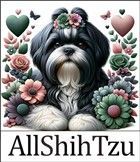White
White Shih Tzu
Facts About White Shih Tzu Dogs
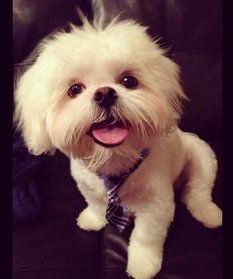
Roscoe, photo courtesy of Christina and Tonio Bianca
• White is an accepted and official AKC color with the Shih Tzu breed, yet an alternate one (non-standard), color code A 199.
• When you have a dog breed that can be found in a wide range of colors, it is exceedingly rare to not only find a solid dog, but also find one that is fully white, since white is recessive to other colors. For these reasons, solid white Shih Tzu are not seen very often and are considered to be rare.
• There are many other colors competing and it takes specific breeding to try and produce solid white. Solid white is an extreme piebald, produced by the piebald gene which is recessive; both parents must have this to produce white pups. And even at that, color genes from generations back are still in play, possibly affecting the resulting litters.
• Most breeders do not aim to produce entirely white Shih Tzu, but rather may strive for white with other color accents. This is a popular coat for many who are looking to bring home a puppy, since the possible combinations are endless.
• Most white Shih Tzu will have a base color of white and then have another color or two colors that complement the coat. The secondary colors may be any that are found with this breed (gold, black, red, silver, etc.)
• If a white and multi-colored Shih Tzu has a liver nose (diluted brown nose, sometimes with a pink tint), most often he will be classified as white and liver, regardless of the actual color of those other hairs. And if a white Shih Tzu has a blue nose (a diluted black; a navy with a shiny tint which is exceedingly rare with this breed), the dog will be dubbed as a white and blue, regardless of what other colors may appear alongside the white.
• In looking at mostly white Shih Tzu, you'll notice that the majority of them are white and brindle. Brindle
is a pattern of hairs that have a striping effect) and on whites, this often falls on the head and/or ears. This is a pretty marking, as it accentuates the face.
Examples of White Shih Tzu Dogs
Here, we'll take a look at some beautiful photos showing Shih Tzu that are majorly white with other colors and a couple of surprisingly solid whites. As you'll see, while some look a bit similar, no two are exactly alike and this is one of the wonderful aspects about this breed; each is individually unique.
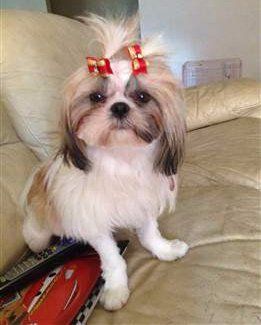
Bella, at 14 months old, photo courtesy of Punahele Welch
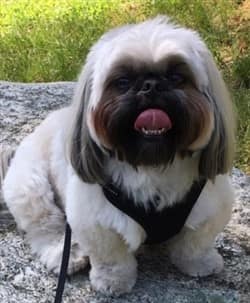
Rusty (he was almost a full rust color when young)
photo courtesy of Max

Marley, at 11 months,
photo courtesy of Rachel Kerr
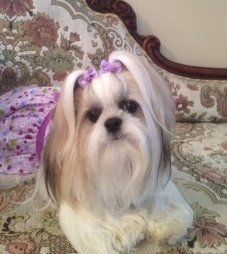
Bella, photo courtesy of Rita Delacruz
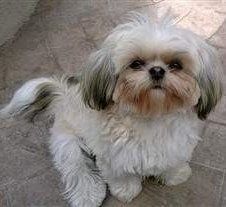
Georgi, at 1 and 1/2 year old,
photo courtesy of Donna Richard

Lexi, photo courtesy of Carla Orense
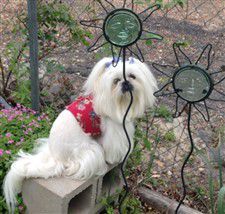
Minnie Pearl, photo courtesy of Tomi Clements
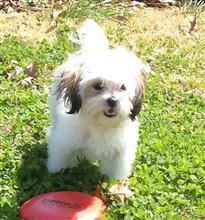
Bailey, photo courtesy The Ramos Family

Tootles, photo courtesy Rick & Linda Johnson

Bugzy Malone, at 1 year old, photo courtesy of Paula & Al
Tips for Taking Care of a White Coat
Please note: AllShihTzu is reader-supported. Some links below are affiliate links, meaning we may earn a small commission on products through these, at no extra cost to you.
If you have a Shih Tzu that is mostly white, you may find it a bit tricky to keep that white looking white; it is not uncommon for the coloring to yellow or easily pick up debris that causes it to lose its shine. Here are some tips:
1)
Use a carefully chosen quality shampoo. If the product is too harsh, it will damage the protective outer layer of the hair strands, this can cause the coat to lose its shine.
If the coat looks dull, gray, or otherwise not as crisp and clean as you'd like the white to appear, use something like Earthbath Light Color Coat Brightener Shampoo ; once the color restores, you can keep using this or switch to Earthbath's oatmeal and aloe formula.
; once the color restores, you can keep using this or switch to Earthbath's oatmeal and aloe formula.
Note that you should keep away from whitening shampoos that have harsh chemicals; some are the equivalent to bleach and can cause severe skin reactions and end up drying out the coat.
2)
Spritz your Shih Tzu every other day with a light, quality leave-in spray. This will protect the coat from picking up debris, protect hairs from UV exposure, help repel small debris and allergens, and help stop split ends which can be very apparent on white coats. A spritz like Chris Christensen Ice on Ice Leave-in Conditioner with Sunscreen
 is a good choice for white dogs; all that's needed is a light mist (don't go overboard).
is a good choice for white dogs; all that's needed is a light mist (don't go overboard).
3)
In between baths, wash off your Shih Tzu's paws when entering back inside (this is also helpful for dogs that have allergies, as allergens are often tracked back into the house).
4)
As often as once a day, wipe the coat down with a grooming wipe. This will help remove all sorts of tiny debris that would otherwise accumulate. A grooming wipe like Earthbath All Natural Grooming Wipes
 is a good choice.
is a good choice.
5)
Be particularly on top of things in regard to tear stains; these will be very noticeable on white Shih Tzu.
Wipe the eye area every day with a grooming wipe (see previous point) and use an effective product to remove staining
if there is discolored hairs.
6)
As always, do not give food and water from plastic bowls; these are notorious for staining hairs and can also lead to nose discoloration as well.
For all Shih Tzu, we recommend stainless steel bowls
that are appropriately sized. These do not cause discoloration, are easy to clean, keep water cold, do not scratch like plastic can, and are heavier, which means that they stay in place better.
More Articles:
Shih Tzu Puppy Teething - What to expect during the teething phase, how to react to gnawing on non-toy objects and a list of helpful teething toys for pups with strong chewing urges.
Shih Tzu Color Information - The main color page that covers all coat colors found with this breed and leads to detailed articles regarding specifics.
As an Amazon Associate, we earn from qualifying purchases. We are a participant in the Amazon Services LLC Associates Program, an affiliate advertising program designed to provide a means for us to earn fees by linking to Amazon.com.
Email: Contact@AllShihTzu.com
All text and images are protected by copyright laws. All rights reserved.
